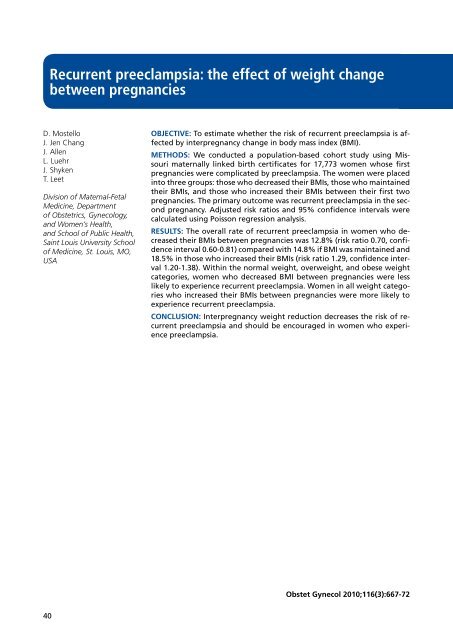AggiornAmenti in riAnimAzione e terApiA intensivA - Pacini Editore
AggiornAmenti in riAnimAzione e terApiA intensivA - Pacini Editore
AggiornAmenti in riAnimAzione e terApiA intensivA - Pacini Editore
Create successful ePaper yourself
Turn your PDF publications into a flip-book with our unique Google optimized e-Paper software.
40<br />
recurrent preeclampsia: the effect of weight change<br />
between pregnancies<br />
D. Mostello<br />
J. Jen Chang<br />
J. Allen<br />
L. Luehr<br />
J. Shyken<br />
T. Leet<br />
Division of Maternal-Fetal<br />
Medic<strong>in</strong>e, Department<br />
of Obstetrics, Gynecology,<br />
and Women’s Health,<br />
and School of Public Health,<br />
Sa<strong>in</strong>t Louis University School<br />
of Medic<strong>in</strong>e, St. Louis, MO,<br />
USA<br />
ObjECTIvE: To estimate whether the risk of recurrent preeclampsia is affected<br />
by <strong>in</strong>terpregnancy change <strong>in</strong> body mass <strong>in</strong>dex (BMI).<br />
METhOdS: We conducted a population-based cohort study us<strong>in</strong>g Missouri<br />
maternally l<strong>in</strong>ked birth certificates for 17,773 women whose first<br />
pregnancies were complicated by preeclampsia. The women were placed<br />
<strong>in</strong>to three groups: those who decreased their BMIs, those who ma<strong>in</strong>ta<strong>in</strong>ed<br />
their BMIs, and those who <strong>in</strong>creased their BMIs between their first two<br />
pregnancies. The primary outcome was recurrent preeclampsia <strong>in</strong> the second<br />
pregnancy. Adjusted risk ratios and 95% confidence <strong>in</strong>tervals were<br />
calculated us<strong>in</strong>g Poisson regression analysis.<br />
RESULTS: The overall rate of recurrent preeclampsia <strong>in</strong> women who decreased<br />
their BMIs between pregnancies was 12.8% (risk ratio 0.70, confidence<br />
<strong>in</strong>terval 0.60-0.81) compared with 14.8% if BMI was ma<strong>in</strong>ta<strong>in</strong>ed and<br />
18.5% <strong>in</strong> those who <strong>in</strong>creased their BMIs (risk ratio 1.29, confidence <strong>in</strong>terval<br />
1.20-1.38). With<strong>in</strong> the normal weight, overweight, and obese weight<br />
categories, women who decreased BMI between pregnancies were less<br />
likely to experience recurrent preeclampsia. Women <strong>in</strong> all weight categories<br />
who <strong>in</strong>creased their BMIs between pregnancies were more likely to<br />
experience recurrent preeclampsia.<br />
COnCLUSIOn: Interpregnancy weight reduction decreases the risk of recurrent<br />
preeclampsia and should be encouraged <strong>in</strong> women who experience<br />
preeclampsia.<br />
Obstet Gynecol 2010;116(3):667-72







